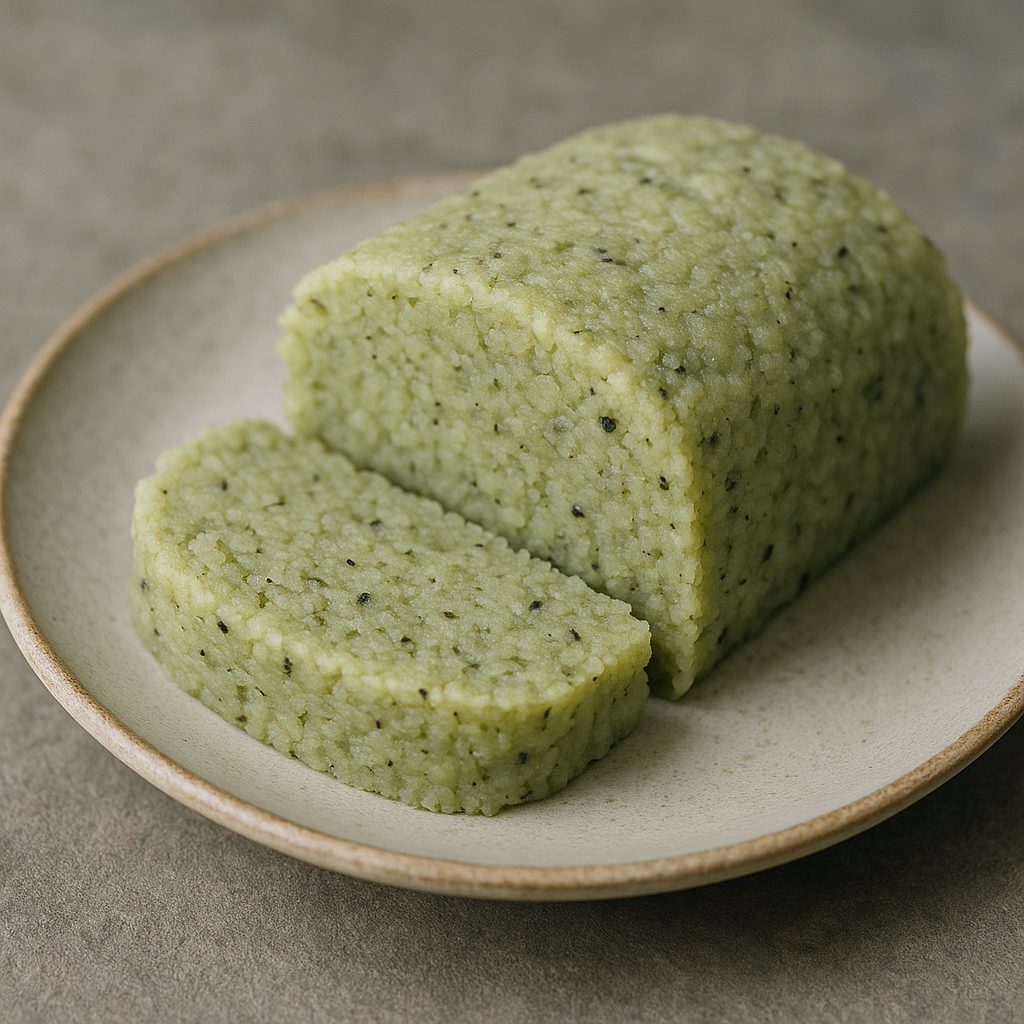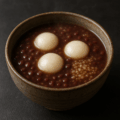豆しとぎ(岩手)の特徴
大豆×米粉×砂糖をこねる、素朴な“生菓子”
岩手の「豆しとぎ」は、ゆでて潰した大豆に米の粉と砂糖を混ぜて練り、棒状にまとめて切り分ける郷土のおやつ。火を通さずそのまま食べられ、香ばしい大豆の風味とやさしい甘さが際立ちます。
ハレとケをつなぐ、お供え菓子
元来は神仏へのお供えから広がり、行事や“こびる(小昼)”のおやつとして定着。地域により、甘さや形、焼き仕上げの有無が異なります。
豆しとぎ(岩手) レシピ
材料(5人分)
- ゆで大豆 … 250g(乾燥大豆約120gを一晩浸水→やや固めにゆでる)
- 米粉(合わせ粉)… 120g(上新粉60g+もち粉60g 目安)
- 砂糖 … 40〜60g(好みで調整)
- 塩 … 2g
- 水 … 80〜120ml(生地の固さで加減)
- (お好みで)白ごま・くるみ … 各少量
作り方
- 大豆を潰す:ゆで大豆の水気をよく切り、温かいうちにすり鉢やマッシャーで粗く潰す(粒感を少し残すと食感が良い)。
- 合わせる:砂糖・塩・水の半量を加えて混ぜ、続けて米粉を加える。耳たぶ程度のしっとり感になるまで、水または米粉で固さを調整する。
- 成形:(あればごま・刻んだくるみを混ぜ)棒状にまとめ、1cm厚に切る。小判形に整えてもよい。
- 仕上げ:そのまま供するか、フライパンで軽く両面を焼いて香ばしさを出す。
シェフのワンポイントアドバイス
- 水分は少しずつ。柔らかすぎたら米粉を、固いときは水を足して調整。
- 砂糖は“おやつ用はやや多め・日常用は控えめ”が目安。
- 焼く場合はオーブントースターで薄く色づく程度に。
栄養価(1人分の目安)
- エネルギー:180〜260 kcal
- たんぱく質:7〜11 g(大豆由来)
- 脂質:4〜8 g
- 炭水化物:28〜36 g
- 食物繊維・カリウム(大豆由来)
歴史
“しとぎ”の作法から生まれた豆の甘味
「しとぎ」は本来、米を搗いて粉にし神前に供えるもの。米が乏しい折には大豆を合わせて量と栄養を補い、甘味を添えて日々のおやつへ。いまも素朴な味わいの郷土菓子として受け継がれています。
English Version
Features of Mame-Shitogi (Iwate)
A simple no-bake sweet kneaded from soybeans, rice flour, and sugar
“Mame-shitogi” is a traditional Iwate treat made by mashing boiled soybeans, mixing in rice flours and sugar, then shaping the dough into logs and slicing. It’s eaten without further cooking, showcasing the toasty aroma of soybeans and a gentle sweetness.
An offering sweet that bridges festive and everyday life
Originally prepared as a food offering to deities, it later became a familiar snack for gatherings and kobiru (midday breaks). Sweetness, shape, and whether to lightly toast the slices vary by household.
Mame-Shitogi (Iwate) Recipe
Ingredients (Serves 5)
- Boiled soybeans … 250 g (from ~120 g dried; soak overnight, boil to firm)
- Rice flour blend … 120 g (joshinko 60 g + mochiko 60 g, as a guide)
- Sugar … 40–60 g (to taste)
- Salt … 2 g
- Water … 80–120 ml (adjust for dough consistency)
- (Optional) White sesame & walnuts … small amounts
Instructions
- Mash the beans: Drain the boiled soybeans well and, while still warm, mash in a suribachi (mortar) or with a masher until mostly smooth with a little texture left.
- Combine: Mix in the sugar, salt, and half the water. Add the rice flour and knead, adjusting with water or flour until the dough is soft and pliable like an earlobe.
- Shape: (If using, mix in sesame or chopped walnuts.) Form into logs and slice into 1 cm thick pieces. Shape into small ovals if you like.
- Finish: Serve as is, or lightly toast both sides in a skillet for extra aroma.
Chef’s Tips
- Add water little by little. If too soft, dust in a bit more rice flour; if too firm, add a splash of water.
- For a snack vibe, use a touch more sugar; for everyday, keep it modest.
- If toasting, use medium-low heat and aim for a pale golden color. It’s most aromatic while warm.
Nutritional Value (per serving, approx.)
- Energy: 180–260 kcal
- Protein: 7–11 g (from soybeans)
- Fat: 4–8 g
- Carbohydrates: 28–36 g
- Dietary fiber & potassium (from soybeans)
History
A bean-based sweet born from the “shitogi” rite
“Shitogi” originally referred to pounded rice offered at shrines. In lean times, soybeans were blended in to stretch volume and nutrition, then sweetened for everyday enjoyment. Today it remains a beloved, down-to-earth confection passed down through Iwate households.



何でも質問してください!